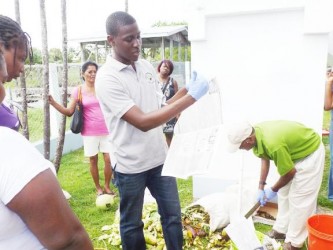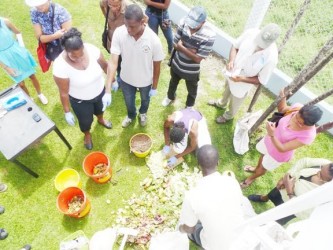Colwayne Morris believes he may be living through a significant period in the evolution of agricultural practices in Guyana and while he concedes that the shade house method is by no means new, he feels a point has been reached where its impact could significantly alter the face of local farming.
With science currently preoccupied with an urgent search for farming methods that are able to respond to the emergency of what is believed to be an imminent global food shortage, Morris, a Field Extension Officer with a local Inter-American Development Bank-supported project is watching the shade house method of farming take root across the country.

Morris told Stabroek Business in an interview last week that he believes the consolidation of the shade house method in Guyana could significantly re-shape local approaches to farming. He says it is not just the fact that the shade house method has generated high levels of interest among traditional farmers that is significant, but also, that it has secured “an entirely new set of converts to farming.”
Morris estimates that the ongoing shade house farming initiative driven by the Partners of the Americas Project has made an impact across all of the regions of Guyana. His own estimate is that more than 700 shade house farmers have been reached by the project though he has no doubt that there might be more, given the fact that the shade house method is far from new here.
Regions in Scandinavia and the Middle East where agricultural pursuits are challenged either by changing weather patterns or by a scarcity of water, have built much of their agricultural production around shade house farming and over time a multi-million dollar industry has sprung up.
Here in Guyana Morris sees the opportunities for shade house farming as centred largely around poverty reduction, primarily in poor rural communities where the advantages to be derived from farming in a controlled environment can be converted into useful income subsidies. Beyond that, he sees no reason why possibilities for transforming shade house farming into an economically viable initiative with money-earning potential at both the domestic and external levels, should not be aggressively pursued.

Morris says the training in shade house agriculture provided by the project has attracted sections of the urban community some of whom had not been known to have been farmers previously. “That is significant,” he says. “What we now have is a method of farming which, it seems, is attracting people who, up until now, had no interest in agriculture.”
Setting aside the link which organisations like the Food and Agricultural Organisation (FAO) sees between food security and shade house farming, Morris says the pursuit opens up new vistas of experimentation and enquiry which adherents find both interesting and challenging. He points out, for example, that indoor planting continues to attract ongoing experimentation with new substrates while the shade house method significantly reduces concerns associated with pests and pesticides. “At a time when there is so much focus on the harmful effects of overuse of pesticides there is something to be said for the popularisation of shade house farming,” Morris says.
After he had returned from Region Nine just over a week ago where the Partners for the Americas project collaborated with IICA to undertake shade house construction exercises and training workshops for students at the Bina Hill Institute and the Annai Secondary School, Morris agreed to brief Stabroek Business on ways in which the project was impacting on shade house farming in the various regions. He explained that natural pesticide production and pest control were integral issues on the training curriculum for shade house adherents.
Morris says interest in the shade house method among farmers in Region Nine can be gauged from questions regarding the sourcing of materials, including plastics for the construction of shade houses.
Morris sees challenges, though not insurmountable ones, ahead. He believes that enthusiasm for shade house agriculture can only be sustained if it is matched by the ability of small farmers to afford the setting up of the shade houses. He estimates that a modest shade house can cost up to around $200,000 to erect with the most expensive input being the ultra violet plastic cover which is key to controlling the environment. More than that, Morris believes that with evidence having already emerged of a few decidedly successful local shade house projects, finding markets for the produce that could come from some of the growing shade house initiatives is a consideration that will have to be addressed.
What pleases him considerably is the fact that there appears to be few if any conflicts between traditional farmers and adherents of shade house farming. Both sides respect the advantages of growing food in an environmentally friendly manner that manages the use of resources like water. Morris says a point has now been reached where conventional farmers are evincing increasing interest in the methods of the shade house farming. “The conventional farmers are beginning to come to us,” Morris says.
Further popularising shade house farming in Guyana remains “a work in progress” though Morris says that this is likely to be driven by evidence of increasing interest in the pursuit in urban communities. Morris says that apart from the income subsidy arising out of the pursuit “the other important consideration is that shade house farming is consistent with the growing focus on eating healthy foods.”





